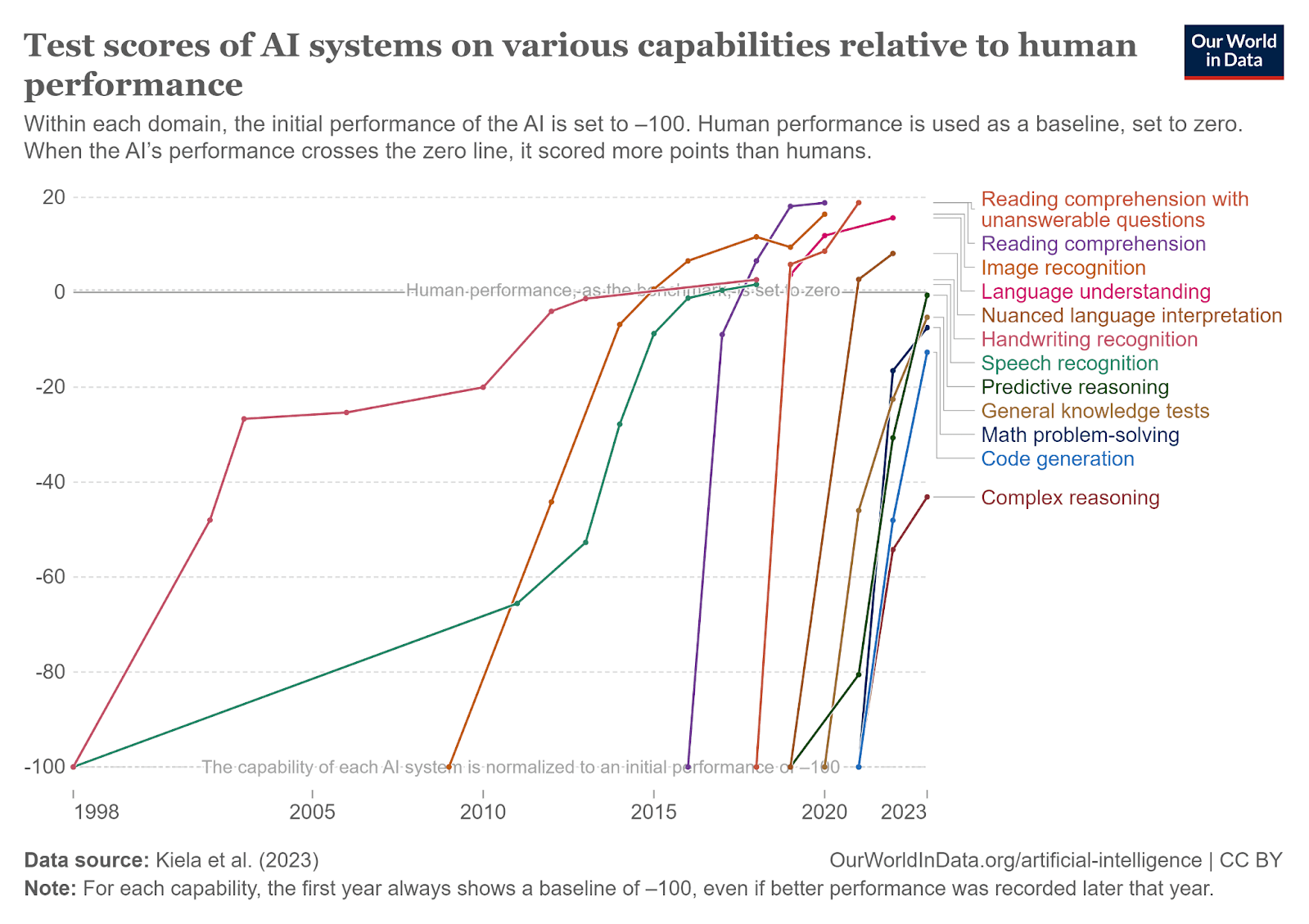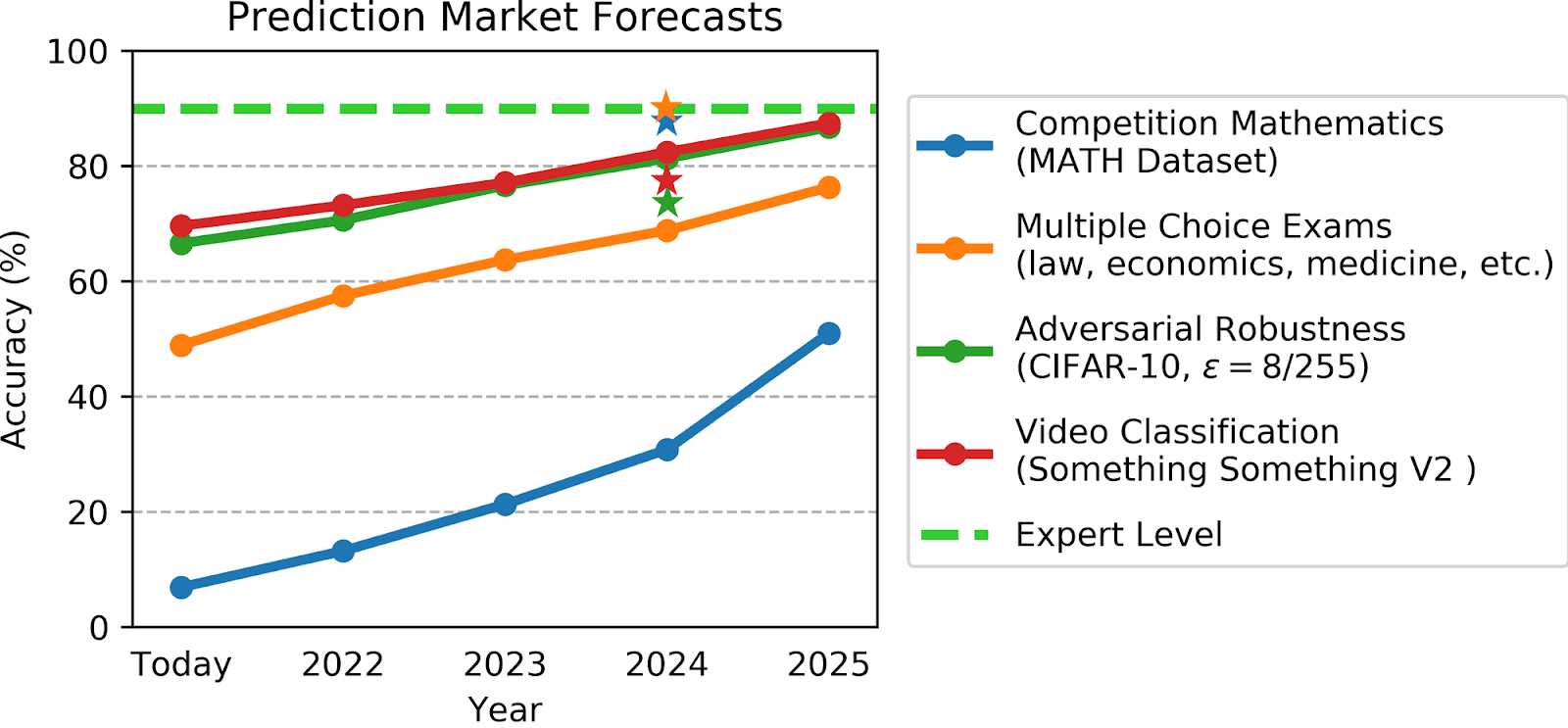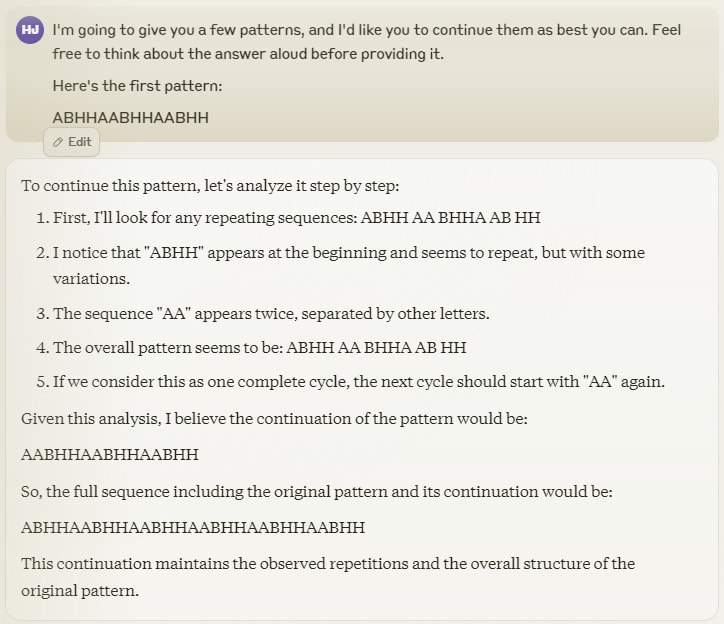Back in June 2023, Soroush Pour and I discussed AI timelines on his podcast, The AGI Show. The biggest difference between us was that I think “machines more intelligent than people are likely to be developed within a few years”, and he thinks that it’s unlikely to happen for at least a few decades.
We haven’t really resolved our disagreement on this prediction in the year since, so I thought I would write up my main reasons for thinking we’re so close to superintelligence, and why the various arguments made by Soroush (and separately by Arvind Narayanan and Sayash Kapoor) aren’t persuasive to me.
Part 1 - Why I Think We Are Close
Empirically
You can pick pretty much any trend relating to AI & computation, and it looks like this:

We keep coming up with new benchmarks, and they keep getting saturated. While there are still some notable holdouts such as ARC-AGI, SWE-Bench, and GPQA, previous holdouts like MATH also looked like this until they were solved by newer models.
If these trends continue, it’s hard to imagine things that AI won’t be able to do in a few years time, unless they are bottlenecked by regulation (like being a doctor), or by robot hardware limitations (like being a professional football player).
Practically
The empirical trends are the result of several different factors; changes in network architecture, choice of hyperparameters, optimizers, training regimes, synthetic data creation, and data cleaning & selection. There are also many ideas in the space that have not been tried at scale yet. Hardware itself is also improving -- chips continue to double in price performance every 2-3 years, and training clusters are scaling up massively.
It’s entirely possible that some of these trends slow down -- we might not have another transformers-level architecture advance this decade, for instance -- but the fact that there are many different ways to continue improving AI for the foreseeable future makes me think that it is unlikely for progress to slow significantly. If we run out of text data, we can use videos. If we run out of that, we can generate synthetic data. If synthetic data doesn’t generalise, we can get more efficient with what we have through better optimisers and training schedules. If that doesn’t work, we can find architectures which learn the patterns more easily, and so on.
In reality, all of these will be done at the same time and pretty soon (arguably already) the AIs themselves will be doing a significant share of the research and engineering needed to find and test new ideas. This makes me think progress will accelerate rather than slow.
Theoretically
Humans are an existence proof of general intelligence, and since human cognition is itself just computation, there is no physical law stopping us from building another general intelligence (in silicon) given enough time and resources.
We can use the human brain as an upper bound for the amount of computation needed to get AGI (i.e. we know it can be done with the amount of computation done in the brain, but it might be possible with less). We think human brains do an equivalent of between 10^12 and 10^28 FLOP per second [a hilariously wide range]. Supercomputers today can do 10^18. The physical, theoretical limit seems to be approximately 10^48 FLOP per second per kilogram.
We can also reason that humans are a lower bound for the compute efficiency of the AGI (i.e. we know that with this amount of compute, we can get human-level intelligence, but it might be possible to do it with less). If humans are more efficient than current AI systems per unit of compute, then we know that more algorithmic progress must be possible as well.
In other words, there seems to be plenty of room for AI capabilities to keep improving before they run into physical limits.
Sanity Check
I generally don’t think arguments from authority are very good, but checking “Do other experts agree or disagree with this conclusion?” can at least help calibrate our priorsbefore thinking through the arguments.
It turns out there is no strong consensus. Shane Legg (Deepmind), Dario Amodei (Anthropic), and Sam Altman (OpenAI) all think that superintelligent AI could be coming within a few years. Yann Lecun (Meta) and Andrew Ng (Stanford) think we have at least decades. The median expert date is 2047 (with the same survey giving a 10% chance by 2027). Prediction markets estimate 2033 (Metaculus) and 2032 (Manifold).
The jury is still out. More detailed write-ups going through expert opinions are here and here, but be aware that views are changing rapidly, and somebody's opinion from 2022 might not be their opinion today.
Part 2 - Response To Arguments Against Short Timelines
I originally was going to write this essay as a rebuttal to this piece called ‘AI Scaling Myths’, but I’ve now found I don’t quite understand why they disagree with my position. Instead, I’ll use that essay as a starting point to broadly cover some of the main positions against near-term superintelligence.
Can LLMs Generalise?
It’s often argued that LLMs are just ‘stochastic parrots’, basically repeating a probability weighted sample of their training set. Critics point to LLMs failure on datasets like ARC-AGI (which they claim require general intelligence to solve) as examples of this. The argument seems to go ‘Nothing like ARC is in the dataset, and LLMs fail on ARC, so this is evidence that they can’t generalise’, for multiple datasets and tasks.
But we also have some evidence that they can generalise, at least a little. I can give Claude lots of different patterns and ask it to continue them, and it will. I can ask it a question, let it give me the wrong answer, and then just ask it to check it’s work, and it will do so and get to the correct answer. I can ask it to write a story, and the story it writes will not be a copy of anything that already exists, even if it is similar.
None of these exact sequences were in the dataset, but the dataset did contain many similar tasks, and the model was able to make the small leap to solve that type of problem in the general case. That’s generalisation!
So why can’t they solve ARC, and other tests, which involve problems that are very different to their training set?
My guess is that their failure is a combination of:
- Not having good tools or structures to solve these sorts of problems.
- Not having an optimal architecture for generalisation.
- Not being large enough or trained for long enough.
- The training set just not being broad enough.
If my guesses here are correct, then in the next few years we should see problem sets like ARC begin to be saturated as each of these items is improved. Seriously, these problems are hard when formatted the way that LLMs are forced to view them. Here’s an ARC problem, the way an LLM sees it:
{"train": [{"input": [[8, 6], [6, 4]], "output": [[8, 6, 8, 6, 8, 6], [6, 4, 6, 4, 6, 4], [6, 8, 6, 8, 6, 8], [4, 6, 4, 6, 4, 6], [8, 6, 8, 6, 8, 6], [6, 4, 6, 4, 6, 4]]}, {"input": [[7, 9], [4, 3]], "output": [[7, 9, 7, 9, 7, 9], [4, 3, 4, 3, 4, 3], [9, 7, 9, 7, 9, 7], [3, 4, 3, 4, 3, 4], [7, 9, 7, 9, 7, 9], [4, 3, 4, 3, 4, 3]]}], "test": [{"input": [[3, 2], [7, 8]], "output": [...] }]}
Try to solve for ‘output’ without reformatting the data, and by only reading through it once, then writing your answer out in a single stream of consciousness. It’s not trivial! The answer in the footnotes.
Regardless, I predict we will reach 85% on ARC by the end of 2025.
Another example of the shortcomings of LLMs was pointed out by Yann LeCun in 2023. He argues that Auto-Regressive LLMs will inevitably fail because errors accumulate -- the probability that each token is “correct” can be very high, but eventually a mistake will be made and the model will go off the rails.
This might be technically correct, as a mathematical statement, but the misleading bit is that it’s only true while the system is entirely auto-regressive (meaning the next token is entirely the result of the previous tokens). A model that interacts with the world (say, by running the code it outputs and receiving the result, or by doing a Google search) now has components that are not autoregressive, so the proof doesn’t apply.
Overall, pointing out the shortcomings of today’s LLMs does not do much to argue against the general trends in AI. RNNs with LTSM had limitations that the transformer architecture fixed, and it was fixed without all the existing work needing to be thrown away -- we use the same kinds of compute, the same kinds of data, the same kinds of optimisers, and so on. I don’t expect LLMs, or transformers generally, to be the last such advance in AI, but I do expect the vast majority of the work on them to transfer over to whatever the next architecture ends up being.
Is Running Out Of Data Going To Stop Progress?
It does seem likely that we’ll run out of publicly available, high quality, human generated text data in the near future.
However, this doesn’t mean progress will slow! We have lots of ways forward!
The most obvious way is just for data efficiency to continue improving. When that report was originally released in 2022, it predicted that text data would be exhausted by 2024. Now, in 2024, it predicts that text data won’t be exhausted until 2028. Why? It was primarily because:
- There were large improvements to the automated filtering of scraped data, which gave a 5x increase to the estimate for available high-quality training data.
- It was discovered that training LLMs for multiple epochs is usually fine, making newly trained models 2-5x more data efficient than predicted.
Also, here we are only talking about text data. Some critics, including the AI Scaling Myths blog post, don’t seem to realise that video, audio, and image data can be used to train multimodal models directly (rather than being transcribed). GPT4o is a native multimodal model, for example.
These other modalities unlock another ~1700 trillion tokens, making real-world data available for another several years of scaling at the current rate.
And that is without considering synthetic data. In domains where the results are verifiable, synthetic data already works extremely well -- AlphaGo, for instance, was trained on millions of games played against itself. We can also generate autonomously verifiable data in maths and programming.
Even if we eventually run out of data in other domains, how far can an AI get with maths and programming? Are those two skills enough to reach a positive feedback loop in AI development without being superhuman in any other domain? I don’t know, but it seems plausible to me. It’s also currently an open question how far we can get with simulated environments, like other games and computer sandboxes, which provide unlimited data and are suitable for training multi-step agents.
Plus, we do see synthetic data generated by LLMs themselves emerging today as well. Nvidia’s Nemotron is an example in this direction, though it is primarily used for fine-tuning existing models rather than generating data for training more-capable base models. Still, one can imagine that for as long as a model can assess its own outputs accurately, it could generate, then filter, those outputs into a new dataset to train on.
Has Progress Slowed Already?
Sometimes people claim that the last few years have represented a slowdown relative to the resources put into AI development, or that recent developments have undershot expectations, especially compared with the high expectations after the release of GPT-4.
I don’t think this is the case. It’s very difficult to give a very clear (i.e. non-cherry-picked) overview, but there have certainly been several serious improvements in the 16 months since GPT-4 was released. In March 2023, standard context windows were ~8000 tokens instead of ~125,000, there were no good video generation engines, frontier models were an order of magnitude more expensive to run, and the benchmark performance was a fair bit worse, especially on maths and coding (most of these you can see by comparing Claude Sonnet 3,5 (June 2024) to GPT-4 (March 2023)).
There were three years between GPT-3 and GPT-4. I think the current pace puts us well on track for a similar level of improvement between GPT-4 and whatever the top model is in 2026, if not more.
We can also check predictions made about AI from three years ago to see if we’ve overshot or undershot expectations. In 2021, Jacob Steinhardt’s group (who also developed some of the benchmarks used) commissioned a forecast which included SOTA estimates on AI in 2024. Here are the predictions compared with today’s results.

The dots are the forecast results, the stars are the actual results.
The forecasts massively undershot actual progress on text-based questions (MATH and MMLU), and somewhat overestimated progress on adversarial robustness and video classification.
Overall, I take this forecast as indicating that the progress made in the past three years is larger than the progress made in the three years before that. It’s harder to compare predictions from after GPT-4 was released (which was only 16 months ago), but there are a few surprising advances, such as silver on the IMO, which seems to have overshot expectations.
This isn’t an argument that predictions today are still underestimating AI (though they very well may be), it’s an argument that the relative progress of AI compared to what was expected a few years ago is fast, not slow.
Do Bio Anchors Mean Human-Level AGI is Impractical with Today’s Compute?
Supercomputers today are well within the range of ‘human-brain compute’ estimates, so we can’t rule out AGI being possible to run with today’s clusters based on bio anchoring to human brain computation.
Regardless, bio anchors are not a reliable way to estimate future progress on AI. There is just too much uncertainty. If we can make a direct comparison at all -- such as with the amount of compute in a brain vs in a digital computer -- our error bars span sixteen orders of magnitude. And if we can’t make a direct comparison -- such as where we try to compare the efforts of evolution to the directed work of human researchers -- it’s not clear we get any useful information at all.
As we get closer to AGI, empirical data matters much more than the very broad assumptions we get from bio anchors, and this has been moving even proponents of the bio anchor’s method towards much shorter timelines -- Ajeya Cotra, for instance, who wrote the most detailed report on bio anchors in 2020, has reduced her personal estimates for when we will reach superintelligence significantly, down to a median date of 2036, nearly twice as fast as the number projected in the original report written just four years ago.
Are We Fundamentally On The Wrong Path For Agentic AI?
LLMs are not the best architecture for agents -- the pre-training does not let the model learn to execute multi-step plans, they can’t natively learn or adapt, they have no memory beyond what is put into their context window, and they must output a token each forward pass.
What does that mean for timelines?
I guess my main thought here is that these limitations are already priced in. Improved algorithms (which include changing architectures) account for about 35% of the improvements made in language modelling since 2014, effectively halving the amount of compute needed to reach a given performance every 8-9 months. If this trend continues, the architecture will evolve, and the current issues will be forgotten just as previous problems were.
And there are plenty of ways for this trend to continue -- for example, we already know that other AI systems do not share these same limitations. RL agents like AlphaZero have no problem finding and executing multi-step plans (albeit in very limited domains) and combination architectures like AlphaGeometry use language models alongside a symbolic engine to search for solutions in a way that LLMs cannot do alone.
These systems have their own limitations, of course, but the fact that they exist makes me more confident (and worried) that we’ll find ways to get the strongest parts of each into a single, general, and superhuman system in the next few years.
We already do reinforcement learning on LLMs post training, and there’s been a lot of progress working around their issues, most notably with RLHF and instruction tuning, and with tool use. Other agentic approaches (such as building structures around the LLM to essentially prompt it better) have led to SWE-Bench going from a ~2% success rate to ~30% in under a year, and current frontier models already quite well on software tasks that take humans under about 15 minutes to do.
All of that said -- even if really significant changes to the architecture are required, I would be surprised if the work being done on compute, data (real and synthetic), and on low level algorithmic improvements (such as to gradient descent optimisers) couldn’t be easily applied to future systems.
Conclusion
As we get closer to developing AGI we move away from vague guesses based solely on trend extrapolation (bio-anchors, compute charts, benchmark progress), and towards having specific designs in mind, that, if built, might be enough.
I think we are at that ‘specific designs’ stage already. We’re not quite at “Let’s go ahead and implement X to build AGI”, but we are definitely at “What if we tried something like Y?”.
Barely eight years ago, as an undergrad, I remember explaining to my friend why Winograd Schemas were such a hard problem. At the time, I couldn’t see a way that they could be solved -- all I could say was that it must be possible (because humans did it) and that maybe in 5 or 10 or 20 years we could figure out how to get a computer to actually understand language.
Today, I wouldn’t be shocked if we reached human-level AGI with something like a 10 trillion parameter transformer-like model which used ternary activations and was trained on next-token prediction across 100 trillion tokens of multimodal real-world data, had another 20 trillion steps of reinforcement learning on synthetic multi-step problems in maths, engineering, and “games”, and which operates within some kind of structure allowing multiple steps of search & planning during inference, and which gives the model some way of actively learning.
That’s not very specific, but it’s a hell of a lot more specific than “I can’t even begin to guess at how to build AGI”, and anybody working at a major lab building frontier models today would have dozens of much better and more specific sets of ideas than this one.
A Few More Notes
- In this essay, I didn’t talk about the alignment problem, or the serious risks we face if superintelligent AI is actually built. That is beyond the scope here, but a detailed summary can be found from Yudkowsky here. The basic idea is simple -- if we create a machine that is very capable of achieving goals, and then we give it a goal, it might go ahead and actually try to achieve it. You will be better at achieving most goals if you are smarter, have more resources, and are not dead. Unfortunately, humans also want those resources.
- I also want to add a disclaimer on my predictions -- 50% odds of AGI by the end of 2029 is a very uncertain estimate, and I don’t think AGI is 90% likely to happen until 2060! My main argument here is that AGI is way more likely to happen this decade than is commonly predicted, and we should be prepared for things to happen quickly. I do try to ground things by giving some intermediate predictions with >80% / <20% credence in footnote 17 (so I expect about 1 in 5 of those to be wrong), but finding specific predictions is much harder than looking at trends, thinking about the question, and coming to “this seems very possible”, which is really what is happening here.
- Epoch AI has been a great source for this essay. I’ve linked to them several times, but I wanted to call them out more explicitly, they do some really great work.
Thanks also to Soroush Pour and Serena Hack for reading and offering suggestions & corrections prior to publication.
FOOTNOTES




